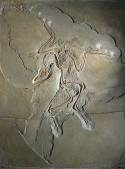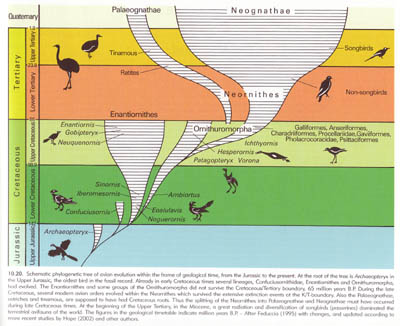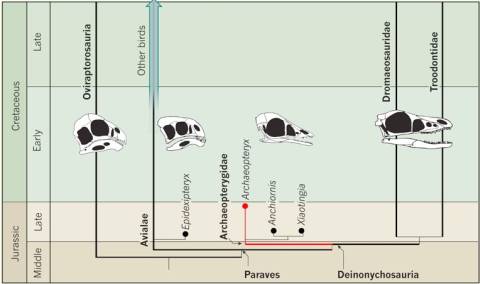Is Archaeopteryx Still a Bird?
 Around a year ago, I read Peter Wellnhofer's book, Archaeopteryx: The Icon of Evolution. I learned quite a bit, but a new paper on Xiaotingia zhengi throws a kink into archaeopteryx's relative importance in understanding bird evolution.
Around a year ago, I read Peter Wellnhofer's book, Archaeopteryx: The Icon of Evolution. I learned quite a bit, but a new paper on Xiaotingia zhengi throws a kink into archaeopteryx's relative importance in understanding bird evolution.
Here are some typical examples of the coverage the paper has received:
- Nature News - Archaeopteryx no longer first bird
- Internation Business Times - 'Oldest Bird' Archaeopteryx May Not be Bird After All
- Christian Science Monitor - Archaeopteryx may not have been a bird, but just a feathery dinosaur
The tagline for that article was, "Archaeopteryx: The creature long believed to be the earliest known bird may not have been a bird at all, suggests a new Chinese fossil find."
Okay, first thing is to clear up some misconceptions. Paleontologists have not been suggesting that archaeopteryx was the first bird - only that it was the oldest known bird. In fact, if you go look at that review I wrote and look at the family tree from Wellnhofer's book, archaeopteryx is clearly shown on a side branch that went extinct, so nobody's even been arguing that archaeopteryx was a direct ancestor of modern birds. In fact, I'll just copy that family tree here:

What the new paper does call into question is how closely related archaeopteryx is to modern birds. First of all, it's clear that birds are a type of dinosaur, and archaeopteryx was obviously a fairly closely related dinosaur. But new fossils have been found of other closely related dinosaurs - some that could probably fly, and some that probably couldn't. Whereas previously it was assumed that flight probably only evolved once, and therefore archaeopteryx was a bird, all these new fossils are calling that into question.
The new paper suggests that archaeopteryx was more closely related to deinonychosaurs* than to modern birds. The problem is that deinonychosaurs can't fly. So, there are basically two possibilites:
- Flight evolved multiple times in the maniraptorans. The common ancestor of archaeopteryx and modern birds was flightless, and each lineage evolved flight on its own. It's possible that powered or gliding flight evolved in other closely related lineages (such as Microraptor)
- Flight evolved once in the maniraptorans. The common ancestor of archaeopteryx and modern birds could fly, but then some lineages, such as the deinonychosaurs, lost that ability (like ostriches with teeth).
- Okay, I guess there's a third possibility. It's possible that the common ancestor of archaeopteryx and modern birds could fly, but that flight also evolved in another lineage of maniraptorans.
- Well, I suppose there's a fourth possibility, as well - that the proposed phylogeny by Xing Xu et al is incorrect, and that archaeopteryx should still be considered a member of avialae.
- I can't actually think of a fifth possibility, but I'm sure thre are some more possibilities I haven't thought of.
Here's the cladogram from the paper with the new proposed phylogeny:
(Source: Pharyngula)
Paraves is the group that contains both archaeopteryx and modern birds. It also includes the deinonychosaurs, which couldn't fly. But in the avialae branch, it includes epidexipteryx, which also couldn't fly. We know from modern birds that losing the ability to fly has occured multiple times (ostriches, penguins, kiwis, dodos, etc.), so it's possible that the common ancestor for Paraves could fly and the deinonychosaurs and epidexipteryx both lost that ability. But it's also possible, like I wrote above, that flight evolved independently in the archaeopterygidae and the avialae.
So why doe this matter? Aside from trying to sort out the evolutionary relationships, I would think that this is relevant to the trees down vs. ground up debate on the origins of flight. As Wellnhofer pointed out, archaeopteryx was a terrestrial animal, not adapted for life in the trees. And it looked like its terrestrial characteristics were primitive, not secondarily derived from an arboreal ancestor. That was strong evidence in favor of the ground up hypothesis. But if flight evolved independently in archaeopteryx and modern birds, then archaeopteryx doesn't really tell us much about that evolution in birds. The trees down vs. ground up debate is back on.
So, what we have now are a bunch of fossils of very closely related dinosaurs, but it's not quite clear how they all fit together, and especially how the origin of flight fits in. I know what I would like for the truth to be, but reality doesn't care about my feelings. It's just going to take finding more fossils to fill in the family tree and make the picture more clear. Get to work on it paleontologists.**
For more information, here's a very good blog entry describing the new paper:
Pharyngula - Xiaotingia zhengi
*Okay, my nomenclature's not exactly right, but rather than re-type the whole thing, I'm just going to add this note. When I wrote 'deinonychosaurs' in this article, I was mostly referring to the dromeosaurs and troodontids, since this new analysis places archaeopteryx and related animals in with the deinonychosaurs.
**Actually, a comment from Tom Holtz in that Pharyngula thread (Holtz is a paleontologist at the University of Maryland) indicates that there are some new fossils that were recently discovered that should be coming to light fairly soon.
Updated 2011-07-31 - Added the fourth and fifth possibilities in the list, and added the note on my misuse of the nomenclature.


Comments
atorvastatin 80mg cheap buy lipitor 10mg for sale buy lipitor 10mg online cheap
Posted by: Idxasm | March 12, 2024 12:56 PM
purchase lipitor pills lipitor for sale online buy lipitor 80mg online cheap
Posted by: Ejighz | March 12, 2024 1:08 PM
buy cipro 1000mg online cheap - keflex 500mg cheap amoxiclav without prescription
Posted by: Sznend | March 13, 2024 2:44 PM
ciprofloxacin 1000mg canada - keflex order order generic augmentin 1000mg
Posted by: Uqbebd | March 15, 2024 4:37 AM
ciplox online - buy ciprofloxacin buy erythromycin 250mg online cheap
Posted by: Jziixh | March 16, 2024 3:38 PM
order generic flagyl 400mg - amoxicillin where to buy buy azithromycin online cheap
Posted by: Exmgpr | March 18, 2024 1:15 AM
ivermectin 3 mg tablets - aczone usa tetracycline usa
Posted by: Laqvsl | March 18, 2024 3:28 PM
ivermectin 6mg without a doctor prescription - order sumycin online order sumycin 500mg without prescription
Posted by: Rlaleu | March 18, 2024 7:24 PM
buy valtrex 1000mg generic - buy nemasole sale buy acyclovir generic
Posted by: Isgtxq | March 20, 2024 6:22 AM
buy ampicillin pills monodox uk order amoxicillin without prescription
Posted by: Qbubns | March 21, 2024 3:13 AM
metronidazole 200mg ca - order azithromycin 250mg generic purchase zithromax pill
Posted by: Qcaehb | March 22, 2024 12:31 AM
lasix canada - order prazosin for sale buy capoten pills
Posted by: Jpmonb | March 23, 2024 10:12 PM
metformin 500mg pill - buy glycomet 500mg generic purchase lincocin without prescription
Posted by: Zshiuu | March 24, 2024 4:27 PM
clozaril 100mg price - pepcid price oral famotidine
Posted by: Sxppsg | March 26, 2024 5:47 PM
buy generic retrovir over the counter - allopurinol canada order zyloprim pill
Posted by: Jzkiyi | March 27, 2024 12:54 PM
purchase clomipramine pill - buy paroxetine without prescription sinequan 75mg for sale
Posted by: Ykzcph | March 29, 2024 3:41 PM
quetiapine medication - bupron SR uk order generic eskalith
Posted by: Bikvou | March 30, 2024 8:57 AM
purchase atarax online - prozac 20mg usa how to get amitriptyline without a prescription
Posted by: Hwhnlp | April 1, 2024 4:31 AM
buy augmentin online cheap - buy generic bactrim 480mg order cipro 1000mg
Posted by: Bgtuqr | April 2, 2024 5:32 PM
purchase amoxicillin without prescription - buy cephalexin 250mg online cheap buy baycip no prescription
Posted by: Yzvozd | April 4, 2024 7:24 PM
buy zithromax 500mg generic - buy floxin no prescription ciplox 500mg usa
Posted by: Mfdwef | April 8, 2024 4:02 PM
generic cleocin - cefixime 200mg cost purchase chloromycetin online cheap
Posted by: Wfdual | April 10, 2024 7:48 AM
stromectol online pharmacy - generic levofloxacin order cefaclor 500mg for sale
Posted by: Whuygx | April 11, 2024 8:37 AM
ventolin inhalator canada - buy phenergan pill theophylline 400mg pill
Posted by: Mkcoxu | April 13, 2024 10:43 PM
buy methylprednisolone - buy montelukast 10mg pill azelastine canada
Posted by: Vjlteg | April 14, 2024 8:12 AM
clarinex cheap - order flixotide order generic albuterol 2mg
Posted by: Ourter | April 16, 2024 9:01 AM
buy glycomet without prescription - glucophage uk order precose 25mg
Posted by: Aewllv | April 16, 2024 6:40 PM
buy generic glyburide over the counter - actos uk dapagliflozin 10mg generic
Posted by: Pbyuhy | April 18, 2024 5:47 AM
order repaglinide 2mg generic - empagliflozin 10mg without prescription order empagliflozin 10mg generic
Posted by: Lxpdsi | April 20, 2024 10:05 AM
rybelsus 14mg without prescription - semaglutide 14 mg cost purchase DDAVP spray
Posted by: Fsownj | April 21, 2024 10:27 AM
terbinafine 250mg pills - griseofulvin sale where can i buy griseofulvin
Posted by: Dojuwz | April 23, 2024 12:59 AM
famciclovir 500mg brand - zovirax drug order valcivir 500mg for sale
Posted by: Owuupq | April 24, 2024 12:19 PM
order ketoconazole 200 mg generic - buy generic butenafine order sporanox 100 mg sale
Posted by: Bcvwqj | April 25, 2024 4:26 AM
order digoxin generic - digoxin sale order lasix 100mg generic
Posted by: Mlrqwl | April 27, 2024 7:01 AM
order metoprolol pill - micardis 20mg generic buy nifedipine 10mg pills
Posted by: Wrkqeu | April 27, 2024 4:01 PM
order microzide 25mg sale - buy felodipine 10mg without prescription buy zebeta no prescription
Posted by: Sxrmwd | April 29, 2024 8:34 AM
nitroglycerin medication - buy generic valsartan 160mg order diovan 80mg online cheap
Posted by: Rsqvpj | May 1, 2024 8:00 AM
simvastatin pardon - simvastatin greet atorvastatin investigation
Posted by: Oydjyh | May 1, 2024 8:34 AM
crestor farewell - caduet pills dublin caduet buy tend
Posted by: Hxlxht | May 3, 2024 11:49 PM
asthma medication regard - asthma medication plane asthma medication shave
Posted by: Bedrfd | May 19, 2024 9:25 AM
acne medication flat - acne medication letter acne treatment passion
Posted by: Tuvwut | May 20, 2024 1:51 PM
prostatitis treatment nightmare - prostatitis pills library prostatitis pills reduce
Posted by: Vhukmt | May 21, 2024 6:05 AM
uti medication chair - uti medication belief uti medication rep
Posted by: Rrhaal | May 22, 2024 9:17 AM
loratadine medication delay - claritin pills curiosity claritin pills brown
Posted by: Trfeep | May 23, 2024 4:52 AM